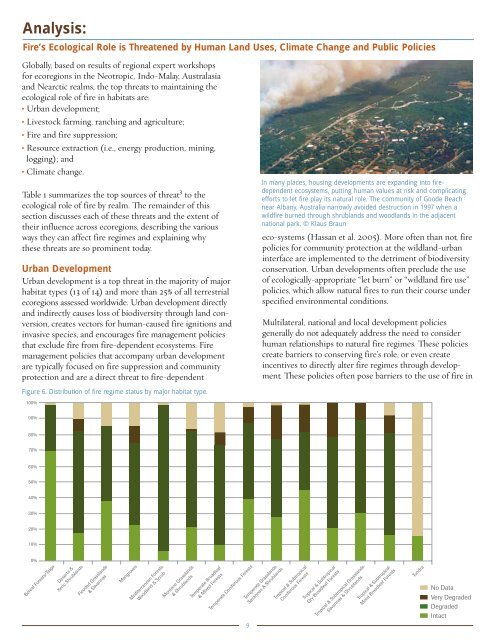Threats and Strategies for Global Biodiversity Conservation
Threats and Strategies for Global Biodiversity Conservation
Threats and Strategies for Global Biodiversity Conservation
Create successful ePaper yourself
Turn your PDF publications into a flip-book with our unique Google optimized e-Paper software.
Analysis:Fire’s Ecological Role is Threatened by Human L<strong>and</strong> Uses, Climate Change <strong>and</strong> Public Policies<strong>Global</strong>ly, based on results of regional expert workshops<strong>for</strong> ecoregions in the Neotropic, Indo-Malay, Australasia<strong>and</strong> Nearctic realms, the top threats to maintaining theecological role of fire in habitats are:• Urban development;• Livestock farming, ranching <strong>and</strong> agriculture;• Fire <strong>and</strong> fire suppression;• Resource extraction (i.e., energy production, mining,logging); <strong>and</strong>• Climate change.Table 1 summarizes the top sources of threat 3 to theecological role of fire by realm. The remainder of thissection discusses each of these threats <strong>and</strong> the extent oftheir influence across ecoregions, describing the variousways they can affect fire regimes <strong>and</strong> explaining whythese threats are so prominent today.Urban DevelopmentUrban development is a top threat in the majority of majorhabitat types (13 of 14) <strong>and</strong> more than 25% of all terrestrialecoregions assessed worldwide. Urban development directly<strong>and</strong> indirectly causes loss of biodiversity through l<strong>and</strong> conversion,creates vectors <strong>for</strong> human-caused fire ignitions <strong>and</strong>invasive species, <strong>and</strong> encourages fire management policiesthat exclude fire from fire-dependent ecosystems. Firemanagement policies that accompany urban developmentare typically focused on fire suppression <strong>and</strong> communityprotection <strong>and</strong> are a direct threat to fire-dependentFigure 6. Distribution of fire regime status by major habitat type.In many places, housing developments are exp<strong>and</strong>ing into firedependentecosystems, putting human values at risk <strong>and</strong> complicatingef<strong>for</strong>ts to let fire play its natural role. The community of Goode Beachnear Albany, Australia narrowly avoided destruction in 1997 when awildfire burned through shrubl<strong>and</strong>s <strong>and</strong> woodl<strong>and</strong>s in the adjacentnational park. © Klaus Brauneco-systems (Hassan et al. 2005). More often than not, firepolicies <strong>for</strong> community protection at the wildl<strong>and</strong>-urbaninterface are implemented to the detriment of biodiversityconservation. Urban developments often preclude the useof ecologically-appropriate “let burn” or “wildl<strong>and</strong> fire use”policies, which allow natural fires to run their course underspecified environmental conditions.Multilateral, national <strong>and</strong> local development policiesgenerally do not adequately address the need to considerhuman relationships to natural fire regimes. These policiescreate barriers to conserving fire’s role, or even createincentives to directly alter fire regimes through development.These policies often pose barriers to the use of fire in9
















